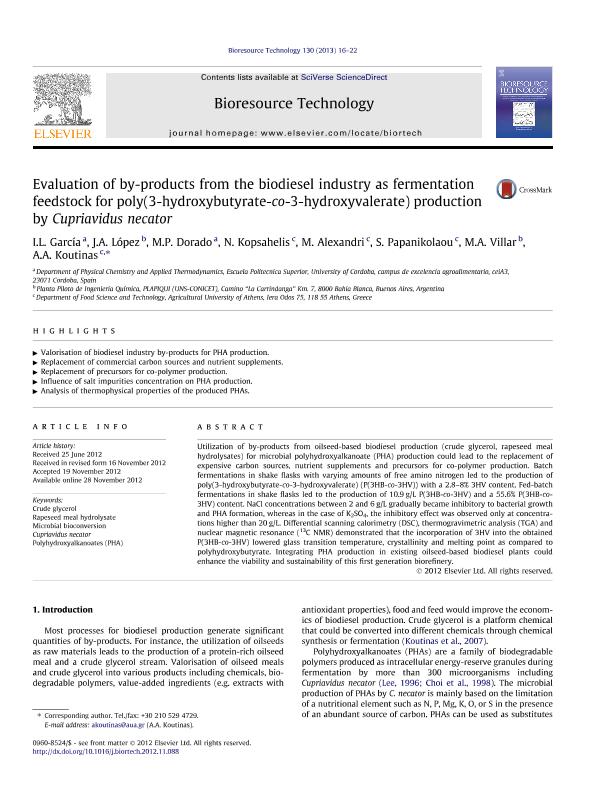Artículo
Evaluation of by-products from the biodiesel industry as fermentation feedstocks for the production of poly(3-hydroxybutyrate-co-3-hydroxyvalerate) by Cupriavidus necator
García, I. L.; Lopez Jimenez, Jimmy Andres ; Dorado, M. P.; Kopsahelis, N.; Alexandri, M.; Papanikolaou, S.; Villar, Marcelo Armando
; Dorado, M. P.; Kopsahelis, N.; Alexandri, M.; Papanikolaou, S.; Villar, Marcelo Armando ; Koutinas, A. A.
; Koutinas, A. A.
 ; Dorado, M. P.; Kopsahelis, N.; Alexandri, M.; Papanikolaou, S.; Villar, Marcelo Armando
; Dorado, M. P.; Kopsahelis, N.; Alexandri, M.; Papanikolaou, S.; Villar, Marcelo Armando ; Koutinas, A. A.
; Koutinas, A. A.
Fecha de publicación:
02/2013
Editorial:
Elsevier
Revista:
Bioresource Technology
ISSN:
0960-8524
Idioma:
Inglés
Tipo de recurso:
Artículo publicado
Clasificación temática:
Resumen
Utilization of by-products from oilseed-based biodiesel production (crude glycerol, rapeseed meal hydrolysates) for microbial polyhydroxyalkanoate (PHA) production could lead to the replacement of expensive carbon sources, nutrient supplements and precursors for co-polymer production. Batch fermentations in shake flasks with varying amounts of free amino nitrogen led to the production of poly(3-hydroxybutyrate-co-3-hydroxyvalerate) (P(3HB-co-3HV)) with a 2.8–8% 3HV content. Fed-batch fermentations in shake flasks led to the production of 10.9 g/L P(3HB-co-3HV) and a 55.6% P(3HB-co-3HV) content. NaCl concentrations between 2 and 6 g/L gradually became inhibitory to bacterial growth and PHA formation, whereas in the case of K2SO4, the inhibitory effect was observed only at concentrations higher than 20 g/L. Differential scanning calorimetry (DSC), thermogravimetric analysis (TGA) and nuclear magnetic resonance (13C NMR) demonstrated that the incorporation of 3HV into the obtained P(3HB-co-3HV) lowered glass transition temperature, crystallinity and melting point as compared to polyhydroxybutyrate. Integrating PHA production in existing oilseed-based biodiesel plants could enhance the viability and sustainability of this first generation biorefinery.
Archivos asociados
Licencia
Identificadores
Colecciones
Articulos(PLAPIQUI)
Articulos de PLANTA PILOTO DE INGENIERIA QUIMICA (I)
Articulos de PLANTA PILOTO DE INGENIERIA QUIMICA (I)
Citación
García, I. L.; Lopez Jimenez, Jimmy Andres; Dorado, M. P.; Kopsahelis, N.; Alexandri, M.; et al.; Evaluation of by-products from the biodiesel industry as fermentation feedstocks for the production of poly(3-hydroxybutyrate-co-3-hydroxyvalerate) by Cupriavidus necator; Elsevier; Bioresource Technology; 130; 2-2013; 16-22
Compartir



